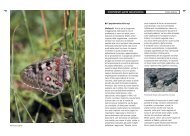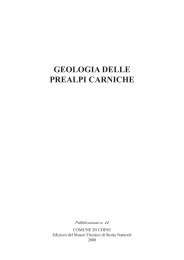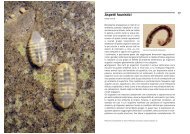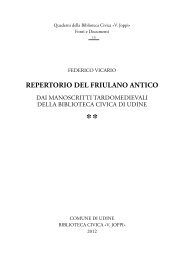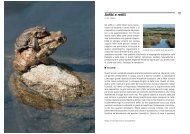Despite its inhospitable appearance and lack of any ... - Udine Cultura
Despite its inhospitable appearance and lack of any ... - Udine Cultura
Despite its inhospitable appearance and lack of any ... - Udine Cultura
Create successful ePaper yourself
Turn your PDF publications into a flip-book with our unique Google optimized e-Paper software.
96<br />
Modified sensory setae on the antennule <strong>of</strong> a male harpacticoid (top: ca. 2000x; bottom: ca. 4000x,<br />
photo by SEM, scanning electron microscopy)<br />
define the so-called “darkness<br />
syndrome”, a condition made up <strong>of</strong> a<br />
series <strong>of</strong> morphological, physiological<br />
<strong>and</strong> behavioural changes that these<br />
species underwent during their<br />
evolution in the geological past, which<br />
brought their ancestors from surface<br />
waters to the underground ecokingdom.<br />
According to how species<br />
react to the underground environment,<br />
adaptations are distinguished from<br />
Aesthetasc on antennule <strong>of</strong> a harpacticoid (ca.<br />
8000x, SEM photo)<br />
specialisations. Adaptations are strategies developed by species as<br />
responses to what are called the macrodescriptors <strong>of</strong> the underground<br />
environment, like constant darkness <strong>and</strong> scarce organic matter. Specialisation<br />
is the reaction to microdescriptors <strong>of</strong> the various types <strong>of</strong> habitats found in the<br />
hypogean environment in general.<br />
Groundwater organisms are depigmented (white, transparent or translucent),<br />
or sometimes pinkish (haematic pigments are visible through their semitransparent<br />
bodies), <strong>and</strong> their visual organs are generally small<br />
(microphthalmy) or totally absent (anophthalmy). Clearly, in totally dark<br />
environments, there is no advantage in having functioning visual organs or<br />
similarly, exhibiting gaudy colours. But it is more complex to underst<strong>and</strong> what<br />
the disadvantages could be in maintaining these characteristics, since these<br />
same disadvantages <strong>of</strong>ten caused them to become extinct over time.<br />
Generally speaking, if an organism has a particular feature that is neither an<br />
advantage nor a disadvantage, a r<strong>and</strong>om neutral mutation may occur, causing<br />
that feature to disappear. In addition, if there is also an energy advantage,<br />
because during the ontogeny <strong>of</strong> these structures available energy can be used<br />
to develop compensatory sensory structures, then the loss <strong>of</strong> useless organs<br />
also has an adaptive logic. Presumably due to <strong>lack</strong> <strong>of</strong> resources, no stygobiont<br />
has developed the complex structures typical <strong>of</strong> animals living in sea abysses<br />
(like bio-luminescence). Moreover, pre-adaptive dynamics cannot be ruled<br />
out: in surface populations made up <strong>of</strong> both blind <strong>and</strong> sighted individuals,<br />
spatial segregation <strong>of</strong> blind phenotypes in groundwater <strong>and</strong> survival <strong>of</strong> sighted<br />
individuals in surface water may have given rise, over time, to two different,<br />
ecologically isolated genotypes. However, the evolutionary dynamics that led<br />
stygobionts to lose their eyes are still being discussed, as even within the<br />
same species eyes may show different evolutionary stages - for example, in<br />
some isopod, amphipod <strong>and</strong> decapod crustaceans.<br />
97




